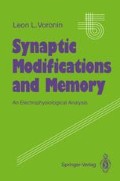Abstract
Chapter 9 shows that the model of transmitter depletion was applied to study synaptic mechanisms. However, many authors used simple variants ignoring mobilization (Sect. 9.3). The more realistic “continuous” model (Sect. 9.4) also often gave deviations from experimental observations even when the “partial depletion” was accepted (Sect. 9.5). Moreover, this variant does not determine independently all model parameters. The “discrete.” model (Sect. 9.4.4) seems to be more attractive but it was used only for analysis of aggregate spinal root responses [205]. The depletion model has been applied to EPSPs of neuro-neuronal synapses only occasionally [226, 954, 1115]. Parameters calculated by different methods were not compared for the same preparation. Many authors regarded parameters of the depletion model as being identical to parameters of the quantum hypothesis. However direct comparisons are scarce and they suggest rather a difference between the related parameters (Sect. 9.8). Therefore, the objectives of our following work were: (1) to modify known methods of the transmitter depletion model; (2) to compare the estimates from different methods with one another and with experimental data; (3) to compare parameters of the depletion model with statistical parameters calculated on the basis of the binomial model of the quantal release. Physiological experiments [1049] were performed on the above described identified monosynaptic connections between LPa7 neurone and giant LPa2 and LPa3 neurones of Helix pomatia (Sects. 2.2.1, 8.6). The related EPSPs are particularly convenient for analysis in the context of the depletion model because they show clear PPD without facilitation even at short interpulse intervals of less then 0.3 s. An interesting additional question was whether the parameters of the synapses formed by the same presynaptic neurone on different postsynaptic neurones were similar. The theoretical part (Sects. 10.2, 10.3) was elaborated together with Dr. V.I.Derevyagin [1025].
Access this chapter
Tax calculation will be finalised at checkout
Purchases are for personal use only
Preview
Unable to display preview. Download preview PDF.
Author information
Authors and Affiliations
Rights and permissions
Copyright information
© 1993 Springer-Verlag Berlin Heidelberg
About this chapter
Cite this chapter
Voronin, L.L. (1993). Parameters of Transmitter Depletion Model for Snail Central Synapses and Comparison of Depletion and Quantal Models. In: Synaptic Modifications and Memory. Studies of Brain Function, vol 19. Springer, Berlin, Heidelberg. https://doi.org/10.1007/978-3-642-47615-0_11
Download citation
DOI: https://doi.org/10.1007/978-3-642-47615-0_11
Publisher Name: Springer, Berlin, Heidelberg
Print ISBN: 978-3-642-47619-8
Online ISBN: 978-3-642-47615-0
eBook Packages: Springer Book Archive

